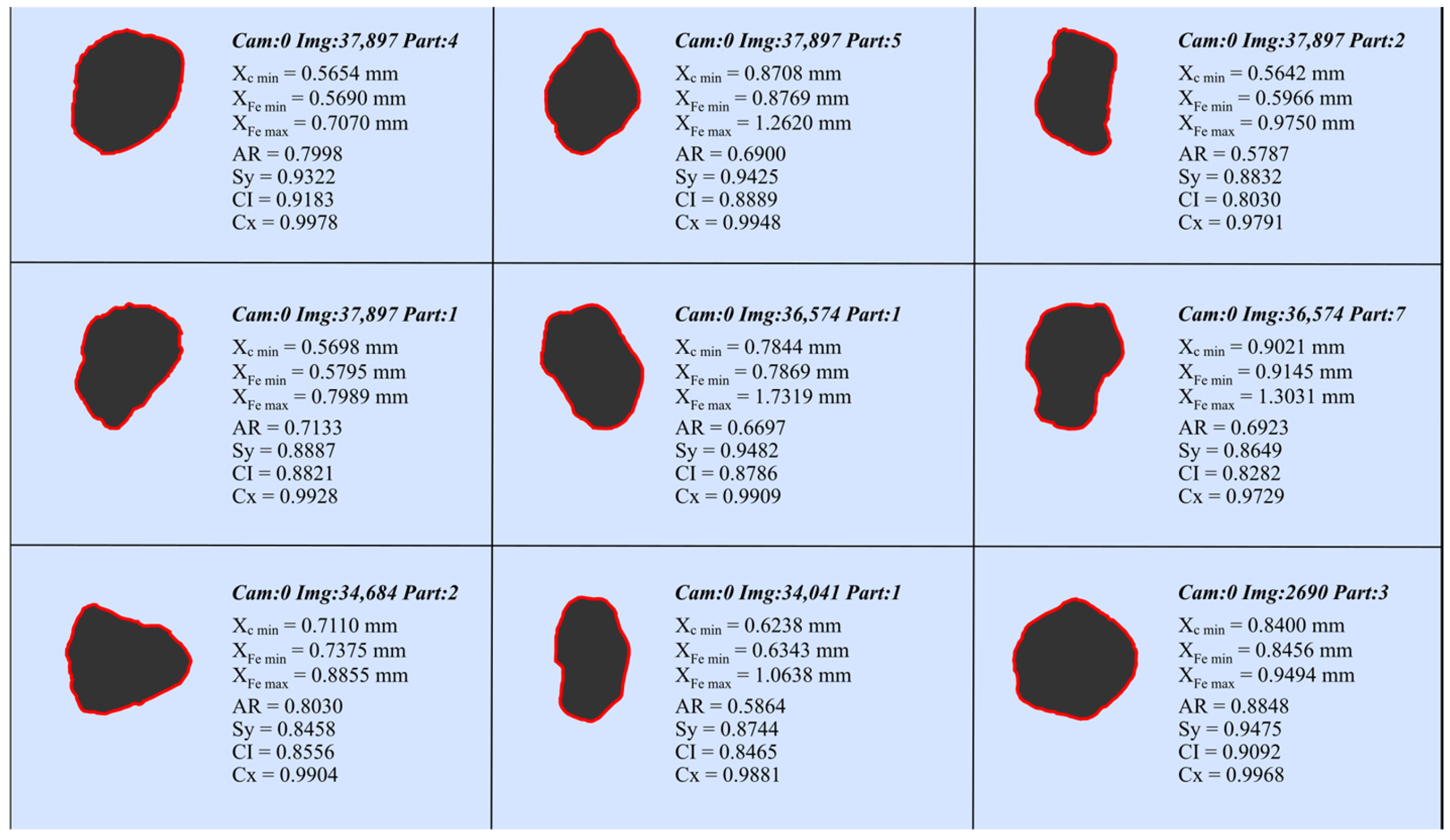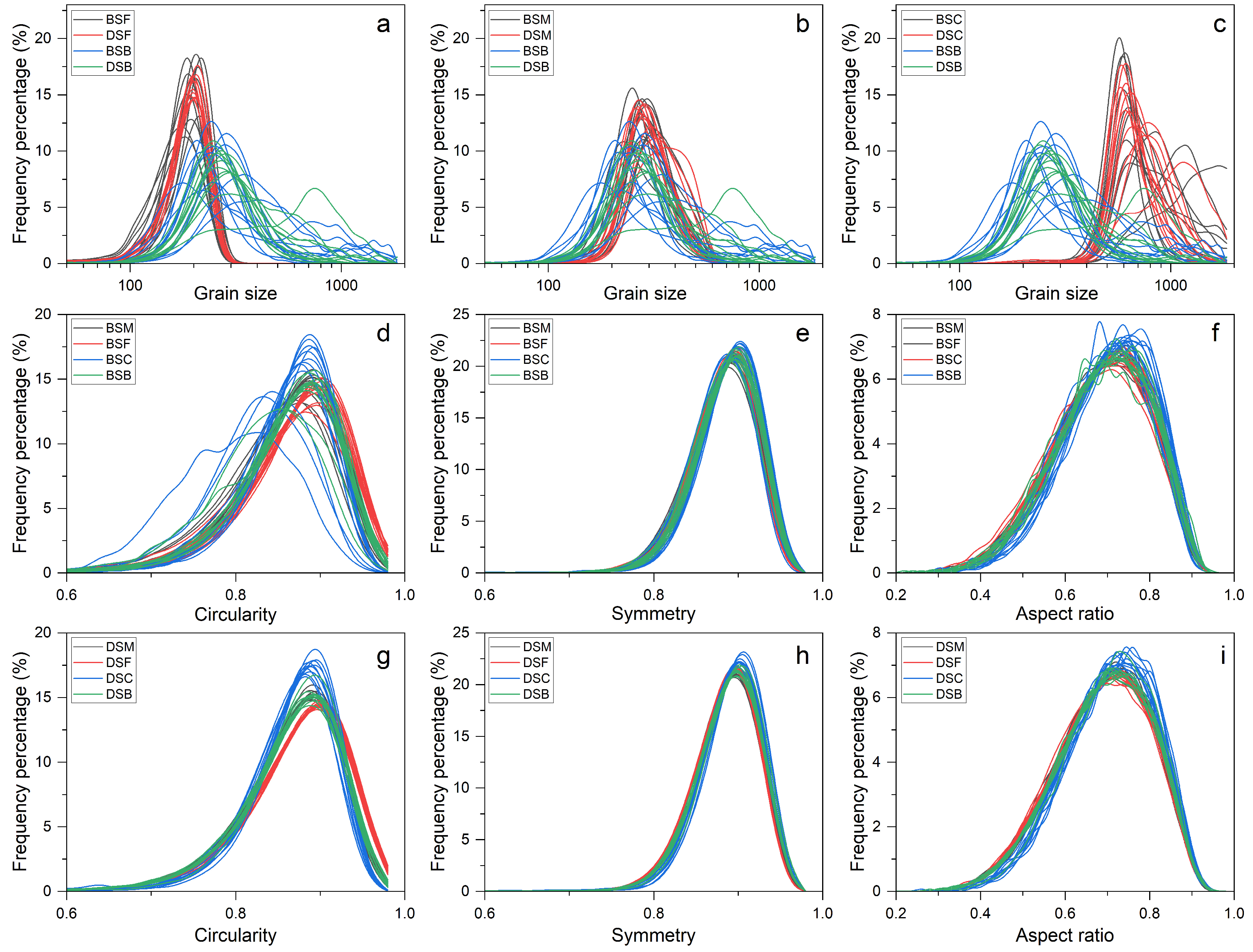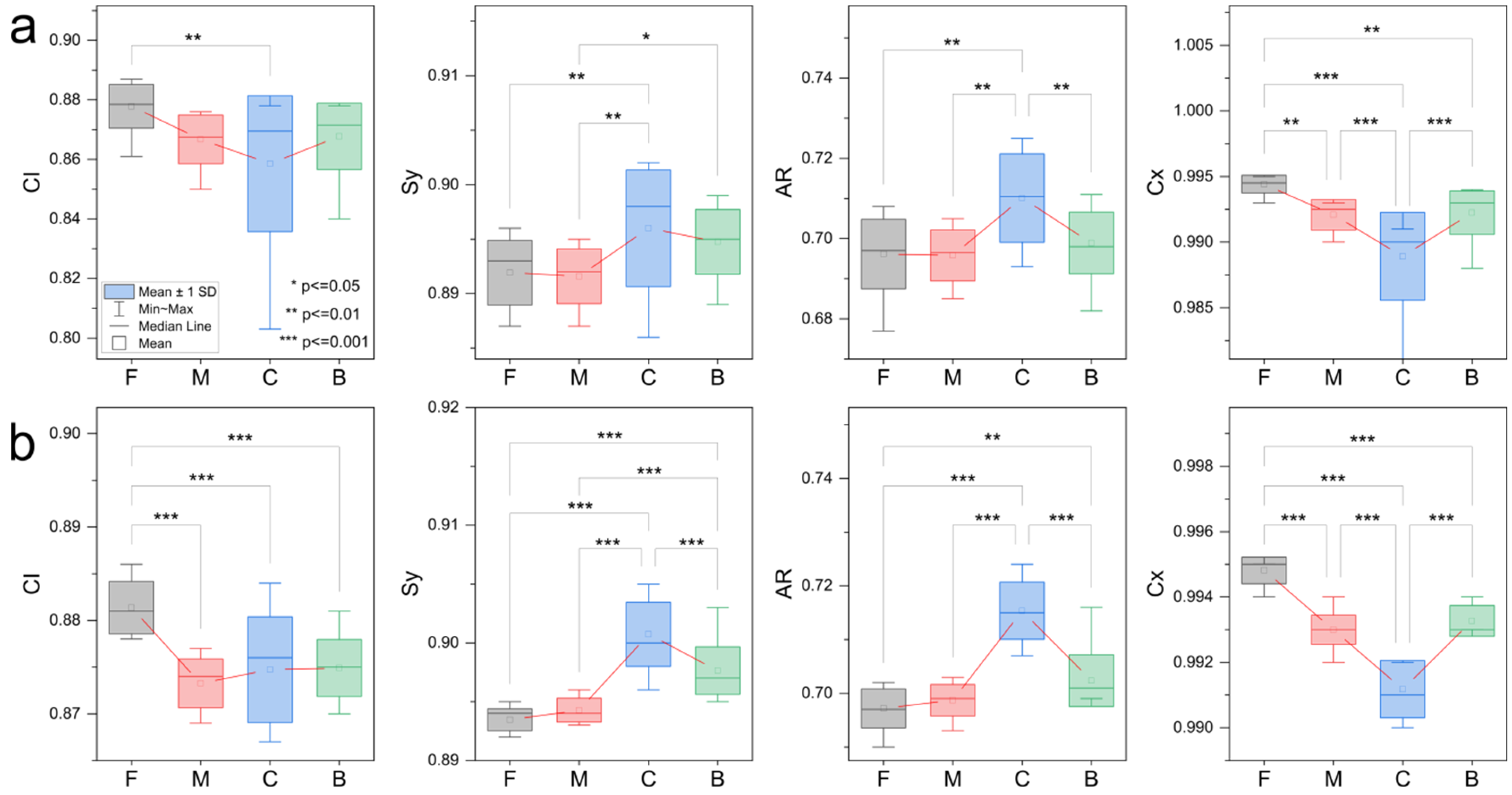Grain Shape Variation of Different Sand-Sized Particles and Its Implication for Discriminating Sedimentary Environment
Abstract
1. Introduction
Regional Background
2. Materials and Methods
3. Results
3.1. Grain Size and Shape Distribution
3.2. Grain Shape Parameter Variations Between Different Size Fractions
3.3. Grain Shape Difference Between Beach Sand and Dune Sand
4. Discussions
4.1. Implications for Grain Shape Variations Across Different Size Fractions
4.2. Integrating Volume- and Number-Weighted Shape Data to Discriminate Sedimentary Environment
5. Conclusions
Author Contributions
Funding
Data Availability Statement
Acknowledgments
Conflicts of Interest
References
- Krumbein, W.C. Measurement and geological significance of shape and roundness of sedimentary particles. J. Sediment. Petrol. 1941, 11, 64–72. [Google Scholar] [CrossRef]
- Li, L.; Iskander, M. Evaluation of Dynamic Image Analysis for Characterizing Granular Soils. Geotech. Test. J. 2019, 43, 20190137. [Google Scholar] [CrossRef]
- Zhang, S.; Dai, H. Effect of diamond grain shape on gallium nitride nano-grinding process. Mater. Sci. Semicond. Process. 2024, 171, 108034. [Google Scholar] [CrossRef]
- Deal, E.; Venditti, J.G.; Benavides, S.J.; Bradley, R.; Zhang, Q.; Kamrin, K.; Perron, J.T. Grain shape effects in bed load sediment transport. Nature 2023, 613, 298–302. [Google Scholar] [CrossRef] [PubMed]
- Gresina, F.; Farkas, B.; Fábián, S.Á.; Szalai, Z.; Varga, G. Morphological analysis of mineral grains from different sedimentary environments using automated static image analysis. Sediment. Geol. 2023, 455, 106479. [Google Scholar] [CrossRef]
- Szabó, T.; Domokos, G.; Grotzinger, J.P.; Jerolmack, D.J. Reconstructing the transport history of pebbles on Mars. Nat. Commun. 2015, 6, 8366. [Google Scholar] [CrossRef]
- Cho, G.C.; Dodds, J.; Santamarina, J.C. Particle shape effects on packing density, stiffness, and strength: Natural and crushed sands. J. Geotech. Geoenviron. Eng. 2006, 132, 105602. [Google Scholar] [CrossRef]
- Liu, F.Y.; Ying, M.J.; Yuan, G.H.; Wang, J.; Gao, Z.Y.; Ni, J.F. Particle shape effects on the cyclic shear behaviour of the soil-geogrid interface. Geotext. Geomembr. 2021, 49, 991–1003. [Google Scholar] [CrossRef]
- Liang, P.; Yang, X. Grain Shape Evolution of Sand-Sized Sediments During Transport From Mountains to Dune Fields. J. Geophys. Res. Earth Surf. 2023, 128, e2022JF006930. [Google Scholar] [CrossRef]
- Cox, E. A method of assigning numerical and percentage values to the degree of roundness of sand grains. J. Paleontol. 1927, 1, 179–183. [Google Scholar]
- Powers, M.C. A New Roundness Scale for Sedimentary Particles. J. Sediment. Res. 1953, 23, 117–119. [Google Scholar] [CrossRef]
- Riley, N.A. Projection sphericity. J. Sediment. Res. 1941, 11, 94–97. [Google Scholar] [CrossRef]
- Hu, F.; Xiao, X.; Fan, Q.; Yu, L.; Xu, Y.; Feng, Y.; Zhou, Y.; Yu, M. Grain size and shape analysis of recent and paleo sediments along Poyang Lake with insight into its environmental significance. Catena 2025, 248, 108588. [Google Scholar] [CrossRef]
- Li, L.; Beemer, R.D.; Iskander, M. Granulometry of Two Marine Calcareous Sands. J. Geotech. Geoenviron. Eng. 2021, 147, 20190137. [Google Scholar] [CrossRef]
- Liu, B.; Cen, W.; Yan, G.; Scheuermann, A.; Zheng, C.; Zhang, P. Particle shape effects on breakage behaviors in granular materials: A multiscale geotechnical perspective. Comput. Geotech. 2025, 187, 107504. [Google Scholar] [CrossRef]
- Maroof, M.A.; Mahboubi, A.; Noorzad, A.; Safi, Y. A new approach to particle shape classification of granular materials. Transp. Geotech. 2020, 22, 100296. [Google Scholar] [CrossRef]
- Chmielowska, D.; Woronko, B.; Dorocki, S. Applicability of automatic image analysis in quartz-grain shape discrimination for sedimentary setting reconstruction. Catena 2021, 207, 105602. [Google Scholar] [CrossRef]
- Li, D.; Kang, Y.; Li, D. Comparison of grain-size and grain-shape characters of alluvial and lakeshore sands based on dynamic image analysis. Quat. Sci. 2015, 25, 484–492, (In Chinese with English Abstract). [Google Scholar] [CrossRef]
- Campaña, I.; Benito-Calvo, A.; Pérez-González, A.; Bermúdez De Castro, J.M.; Carbonell, E. Assessing automated image analysis of sand grain shape to identify sedimentary facies, Gran Dolina archaeological site (Burgos, Spain). Sediment. Geol. 2016, 346, 72–83. [Google Scholar] [CrossRef]
- Cheng, W.; Chen, S.; Zhu, J.; Zhong, X.; Hu, J.; Guo, J. Identification of the Sediment Movement Mechanism via Grain Size and Shape: A Case Study of a Beach in Eastern Hainan Island in South China. Water 2023, 15, 3637. [Google Scholar] [CrossRef]
- Gale, S. The shape of fluvial gravels; insights from Fiji’s Sabeto River. Geosciences 2021, 11, 161. [Google Scholar] [CrossRef]
- Zhang, Q. Study on the Changes of Hydrological Situation in Poyang Lake; Science Press: Beijing, China, 2018. [Google Scholar]
- Han, Z.; Li, X.; Zhang, Z. Genesis of ridge like landform on sand hill on the shore of the Poyang Lake. Acta Geogr. Sin. 2010, 65, 331–338, (In Chinese with English Abstract). [Google Scholar] [CrossRef]
- Liu, J.; Wu, X.H.; Li, S.Q.; Zhang, M.S. The last glacial stratigraphic sequence, depositional environment and climatic fluctuations from the aeolian sand dune in Hongguang, Pengze, Jiangxi (China). Quat. Sci. Rev. 1997, 16, 535–546. [Google Scholar] [CrossRef]
- Fryberger, S.G. Dune forms and wind regime. In A Study of Global Sand Seas; McKee, E.D., Ed.; Professional Paper, 1052; United States Government Printing Office: Washington, DC, USA, 1979; pp. 137–169. [Google Scholar]
- Hu, F.; Jianhui, J.; Xie, M.; Xiao, Z.; Cao, M.; Zhou, Y.; Liang, J. Insights into the age and genesis of the clay dunes in the Suhongtu Basin, Alashan Plateau, China. Geomorphology 2022, 408, 108241. [Google Scholar] [CrossRef]
- Hu, F. Downstream Fining and Rounding in Sand-Bed River and Its Significance: A Case Study from the Ganjiang River, China; Mendeley Data, V1; 2025. Available online: https://data.mendeley.com/datasets/kc9ymdt8fm/1 (accessed on 23 October 2025).
- Bui, E.N.; Mazzullo, J. Using quartz grain size and shape analysis to distinguish between Aeolian and fluvial deposits in the Dallol Bosso of Niger (West Africa). Earth Surf. Process. Landf. 1989, 14, 157–166. [Google Scholar] [CrossRef]
- Mazzullo, J.; Sims, D.; Cunningham, D. The effects of eolian sorting and abrasion upon the shapes of fine quartz sand grains. J. Sediment. Petrol. 1986, 56, 45–56. [Google Scholar] [CrossRef]
- Shang, Y.; Kaakinen, A.; Beets, C.J.; Prins, M.A. Aeolian silt transport processes as fingerprinted by dynamic image analysis of the grain size and shape characteristics of Chinese loess and Red Clay deposits. Sediment. Geol. 2018, 375, 36–48. [Google Scholar] [CrossRef]
- Lira, C.; Pina, P. Automated Grain Shape Measurements Applied to Beach Sands. J. Coast. Res. 2009, SI, 1527. [Google Scholar]
- Patro, B.; Sahu, B. Factor analysis of sphericity and roundness data of clastic quartz grains: Environmental significance. Sediment. Geol. 1974, 11, 59–78. [Google Scholar] [CrossRef]
- Livingstone, I.; Warren, A. Aeolian Geomorphology; John Wiley & Sons Ltd.: Hoboken, NJ, USA, 1996. [Google Scholar]
- Frings, R.M. Downstream fining in large sand-bed rivers. Earth-Sci. Rev. 2008, 87, 39–60. [Google Scholar] [CrossRef]
- Krumbein, W.C. The Effects of Abrasion on the Size, Shape and Roundness of Rock Fragments. J. Geol. 1941, 49, 482–520. [Google Scholar] [CrossRef]
- Bray, E.N.; Litwin Miller, K.; Cardona, M.; Pettyjohn, S.; Sklar, L.S. Influence of particle lithology, size and angularity on rates and products of bedload wear: An experimental study. Earth Surf. Process. Landf. 2024, 49, 4972–4990. [Google Scholar] [CrossRef]
- Domokos, G.; Gibbons, G.W. The evolution of pebble size and shape in space and time. Proc. R. Soc. A 2012, 468, 3059–3079. [Google Scholar] [CrossRef]
- Lindsey, D.A.; Langer, W.H.; Van Gosen, B.S. Using pebble lithology and roundness to interpret gravel provenance in piedmont fluvial systems of the Rocky Mountains, USA. Sediment. Geol. 2007, 199, 223–232. [Google Scholar] [CrossRef]
- Litty, C.; Schlunegger, F. Controls on Pebbles’ Size and Shape in Streams of the Swiss Alps. J. Geol. 2017, 125, 101–112. [Google Scholar] [CrossRef]
- Mazzullo, J.; Alexander, A.; Tieh, T.; Menglin, D. The effects of wind transport on the shapes of quartz silt grains. J. Sediment. Petrol. 1992, 62, 961–971. [Google Scholar] [CrossRef]
- Liang, W.; Hu, X.; Garzanti, E.; Dong, X.; Zhang, Y. Fluvial-Aeolian Interaction and Compositional Variability in the River-Fed Yarlung Tsangpo Dune System (Southern Tibet). J. Geophys. Res. Earth Surf. 2023, 128, e2022JF006920. [Google Scholar] [CrossRef]
- Mason, C.C.; Folk, R.L. Differentiation of beach, dune, and aeolian flat environments by size analysis, Mustang Island, Texas. J. Sediment. Petrol. 1958, 28, 211–226. [Google Scholar] [CrossRef]
- Shepard, F.P.; Manar, R.Y.; Young, R. Distinguishing between beach and dune sands. J. Sediment. Petrol. 1961, 31, 196–214. [Google Scholar] [CrossRef]
- Vincent, P. Variation in particle size distribution on the beach and windward side of a large coastal dune, southyest France. Sediment. Geol. 1996, 103, 273–280. [Google Scholar] [CrossRef]
- Saha, K.; Sinha, S. Distinguishing depositional environments in the beach–dune system of Chandipur, India, based on sediment texture and quartz grain surface features. Earth Surf. Process. Landf. 2023, 48, 1251–1266. [Google Scholar] [CrossRef]
- Liu, B.; Coulthard, T.J. Mapping the interactions between rivers and sand dunes: Implications for fluvial and aeolian geomorphology. Geomorphology 2015, 231, 246–257. [Google Scholar] [CrossRef]
- Russell, R.D.; Taylor, R.E. Roundness and shape of Mississippi River sands. J. Geol. 1937, 45, 225–267. [Google Scholar] [CrossRef]
- Dong, Y. Review on 10 Groups of Demarcating Grain Sizes of River Sediment. J. Yangtze River Sci. Res. Inst. 2018, 35, 1–7. [Google Scholar]







| Based on the Volume Weighting of the Data | ||||||||
|---|---|---|---|---|---|---|---|---|
| Fraction | CI | sd | Sy | sd | AR | sd | Cx | sd |
| BSF | 0.878 | 0.0073 | 0.892 | 0.0030 | 0.696 | 0.0086 | 0.994 | 0.0007 |
| DSF | 0.881 | 0.0028 | 0.893 | 0.0009 | 0.697 | 0.0036 | 0.995 | 0.0004 |
| BSM | 0.867 | 0.0081 | 0.892 | 0.0025 | 0.696 | 0.0064 | 0.992 | 0.0012 |
| DSM | 0.873 | 0.0026 | 0.894 | 0.0010 | 0.699 | 0.0029 | 0.993 | 0.0004 |
| BSC | 0.859 | 0.0228 | 0.896 | 0.0053 | 0.710 | 0.0110 | 0.989 | 0.0033 |
| DSC | 0.875 | 0.0057 | 0.901 | 0.0027 | 0.715 | 0.0053 | 0.991 | 0.0009 |
| BSB | 0.868 | 0.0111 | 0.895 | 0.0030 | 0.699 | 0.0077 | 0.992 | 0.0017 |
| DSB | 0.875 | 0.0031 | 0.898 | 0.0020 | 0.702 | 0.0048 | 0.993 | 0.0005 |
| Based on the number weighting of the data | ||||||||
| BSF | 0.918 | 0.0038 | 0.889 | 0.0015 | 0.714 | 0.0049 | 0.998 | 0.0000 |
| DSF | 0.929 | 0.0015 | 0.888 | 0.0008 | 0.724 | 0.0034 | 0.998 | 0.0004 |
| BSM | 0.923 | 0.0041 | 0.888 | 0.0013 | 0.717 | 0.0048 | 0.998 | 0.0003 |
| DSM | 0.932 | 0.0016 | 0.888 | 0.0009 | 0.726 | 0.0019 | 0.999 | 0.0000 |
| BSC | 0.923 | 0.0059 | 0.887 | 0.0039 | 0.717 | 0.0074 | 0.998 | 3.0000 |
| DSC | 0.933 | 0.0022 | 0.887 | 0.0007 | 0.728 | 0.0025 | 0.999 | 0.0005 |
| BSB | 0.920 | 0.0061 | 0.888 | 0.0021 | 0.718 | 0.0067 | 0.998 | 0.0003 |
| DSB | 0.931 | 0.0016 | 0.888 | 0.0012 | 0.726 | 0.0020 | 0.999 | 0.0003 |
Disclaimer/Publisher’s Note: The statements, opinions and data contained in all publications are solely those of the individual author(s) and contributor(s) and not of MDPI and/or the editor(s). MDPI and/or the editor(s) disclaim responsibility for any injury to people or property resulting from any ideas, methods, instructions or products referred to in the content. |
© 2025 by the authors. Licensee MDPI, Basel, Switzerland. This article is an open access article distributed under the terms and conditions of the Creative Commons Attribution (CC BY) license (https://creativecommons.org/licenses/by/4.0/).
Share and Cite
Hu, F.; Xiao, X. Grain Shape Variation of Different Sand-Sized Particles and Its Implication for Discriminating Sedimentary Environment. Geosciences 2025, 15, 412. https://doi.org/10.3390/geosciences15110412
Hu F, Xiao X. Grain Shape Variation of Different Sand-Sized Particles and Its Implication for Discriminating Sedimentary Environment. Geosciences. 2025; 15(11):412. https://doi.org/10.3390/geosciences15110412
Chicago/Turabian StyleHu, Fangen, and Xia Xiao. 2025. "Grain Shape Variation of Different Sand-Sized Particles and Its Implication for Discriminating Sedimentary Environment" Geosciences 15, no. 11: 412. https://doi.org/10.3390/geosciences15110412
APA StyleHu, F., & Xiao, X. (2025). Grain Shape Variation of Different Sand-Sized Particles and Its Implication for Discriminating Sedimentary Environment. Geosciences, 15(11), 412. https://doi.org/10.3390/geosciences15110412





